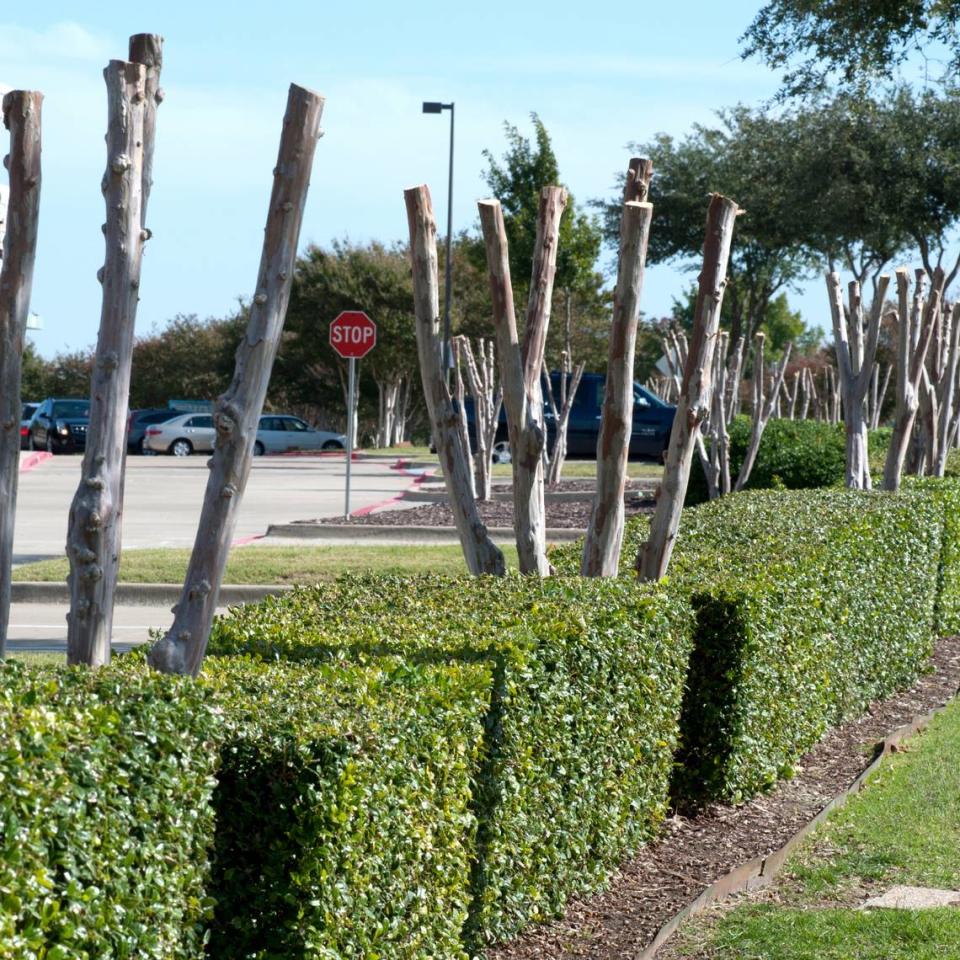Be careful with the pruning shears! Avoid these mistakes in your North Texas garden
We make some serious mistakes when we pick up the pruning saws and shears. Some ruin our plants forever. Allow me to point them out in the hopes that I can save a few bad turns in your groundskeeping.
▪ We prune at the wrong times. Granted, much pruning is best done in the winter season while plants are dormant (evergreens, fruit trees, shade trees, and others). But if you prune spring-flowering shrubs and vines then you’ll be cutting away most of their buds. Instead, trim them immediately after their spring bloom. Prune blackberries immediately after you harvest their fruit and cut the fruiting canes back to the ground. Leave the new canes alone. They’ll produce fruit next year — they fruit on one-year-old canes only.
▪ Bush roses are pruned by 50% during the first half of February. Each cut should be made just above a bud that faces away from the center of the plant. Remove weak, non-productive growth. Know what rose rosette virus looks like and remove all infected plants immediately, roots and all.
▪ Never top a crape myrtle for any possible reason. It won’t make them bloom any better. In fact, they will bloom later and with fewer rounds of blooms per summer. Plus, it will ruin their natural growth form permanently. And it won’t change their genetics — if they’re too tall or too wide, they’ll grow right back after the pruning. Either move or remove them.

▪ When pruning limbs off large shade trees, use the three-step approach. The first cut should be from below and 15 or 18 inches out from the trunk. Cut up 1/4-way into the bottom of the branch (not far enough that you saw is pinched by the weight of the branch). Move 3 to 4 inches farther out on the branch and cut from the top down until the weight of the branch causes it to fall. It will peel the bark on the underside back to your starting undercut. Third and final cut should be almost flush with the main trunk or next branch so that you leave a small section of the branch collar but no stub of the old branch. That will allow the “roll” of new bark to form across the open wound for fastest possible healing. Seal all cuts larger than a broomstick in diameter made to oak trees, no matter what time of year they are made. All other species should be left to heal on their own without pruning sealant.
▪ Oaks should only be pruned between mid-summer and mid-February. They should never be pruned from Valentine’s Day through the middle of July. Those are times that the fatal oak wilt fungus is active in Texas.
▪ Removing lower branches from large shade trees may allow a bit of extra sunlight to reach turfgrass beneath the trees early in morning and late in the evening. However, it’s very possible that it won’t be enough extra light to keep the turfgrass alive and vigorous. It may be time to switch to a shade-tolerant groundcover instead.
Speaking of that kind of pruning, once branches have been removed they can never be put back again. Tell that to the scores of shopping center owners who have asked their tree maintenance people that their parking lot trees be “limbed up” to allow traffic driving past to see all their merchants. Instead, they’ve ended up mangling their trees forever. No one is served well in that debacle, certainly not the city that required that the trees be planted in the first place.
▪ Buy shrubs that grow to mature heights and widths to match the space you have available for them. Unless you have a very formal landscape, avoid pruning into square or round shapes. They make extra work for you, and they shorten the plants’ life expectancy by repeatedly removing new growth. The easiest way around this unnatural type of pruning is to use lopping shears more and electric or gasoline hedge trimmers less.
▪ Letting turfgrass grow taller does nothing to improve its winter hardiness or summer heat and drought resistance. Learn the best mowing height for the type of grass that you’re growing and stick with it 12 months a year. In general terms, mowing low encourages denser turf that’s better able to ward off invading weeds.
▪ When using a line trimmer, take great care not to nick the bark of your trees. Just inside the bark is the phloem, and it’s in that cylindrical tissue that plants send manufactured sugars from the leaves down to the roots. If you lose the bark at any point all the way around the trunk you will almost assuredly lose the tree. It’s best to feather the lawn down to bare soil a couple of inches out away from the trunk so that you’re never trimming right up against the bark.
▪ If you have surface roots that are beginning to be a hazard within your lawn, this could be the perfect time to remove them. If you have a root that is threatening to crack your sidewalk, patio or even foundation, dig the soil out around it and cut through it with a hand saw or axe. If a chain saw hits soil its blade will be instantly dulled.
By trimming out an offending root now you give the tree six months to make alternate “plans” before next summer’s heat and dry weather return. Whatever you do, don’t cover the roots with new topsoil. You’ll never win that race. The root will continue to grow and swell, and the earthen mound will become a distraction.

